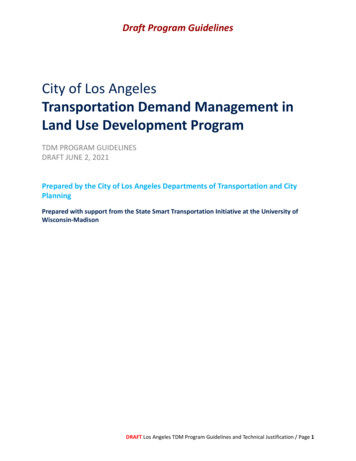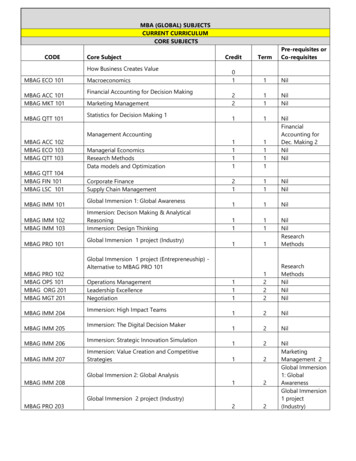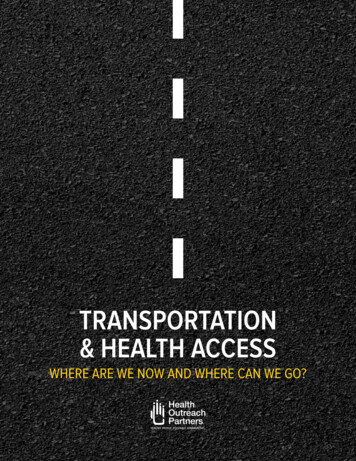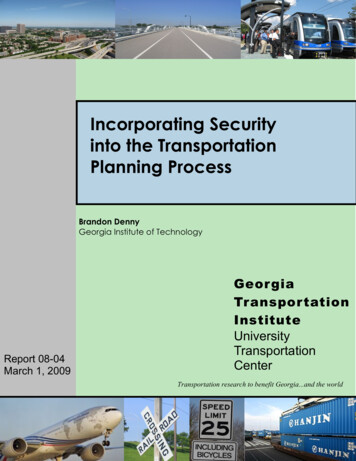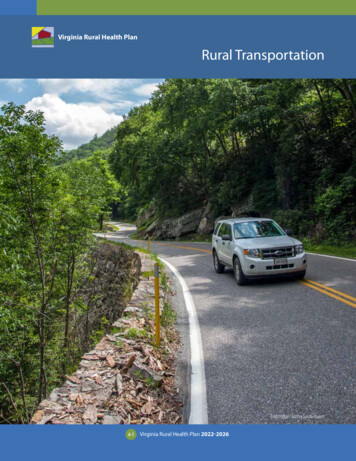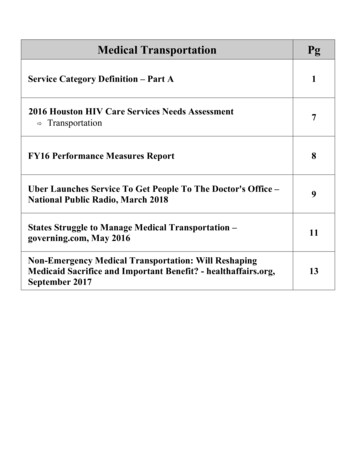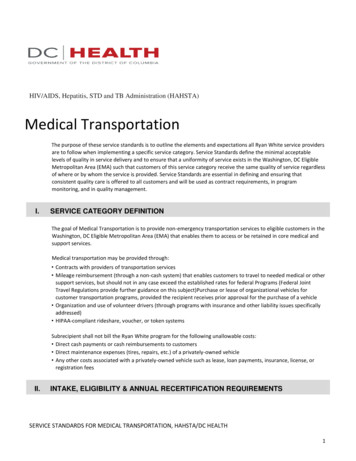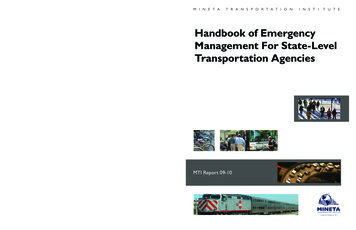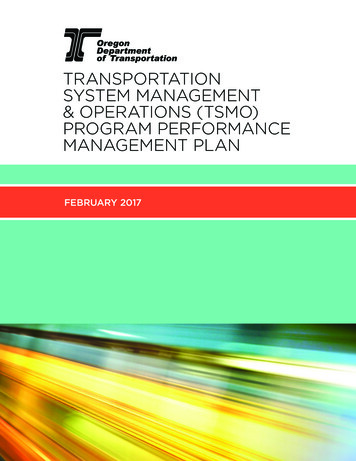
Transcription
TRANSPORTATIONSYSTEM MANAGEMENT& OPERATIONS (TSMO)PROGRAM PERFORMANCEMANAGEMENT PLANFEBRUARY 2017
TSMO Program Performance Mangement PlanTABLE OFCONTENTSEXHIBITS13EXHIBIT 1. TIM CORE PERFORMANCEMEASURES14EXHIBIT 2. TIM KEY PERFORMANCEMEASURES WITH FUTURE TIME GOALS21EXHIBIT 3. TOC MANAGEMENT COREPERFORMANCE MEASURES25EXHIBIT 4. MOBILITY DATA SOURCES TO BEFUSED IN MOBILITY DATABASE(S)27EXHIBIT 5. MOBILITY CORE PERFORMANCEMEASURES34EXHIBIT 6. PURDUE COORDINATIONDIAGRAM, US 101 LINCOLN CITY, OR (ATSPMSOFTWARE)35EXHIBIT 7. PURDUE SPLIT FAILUREDIAGRAM, ATSPM PRESENTATION, DR.DARCY BULLOCK38EXHIBIT 8. TRAVELER INFORMATION COREPERFORMANCE MEASURES48 WORK MANAGEMENT44APENDICESEXHIBIT 9. ASSET MANAGEMENT COREPERFORMANCE MEASRURES49EXHIBIT 10. WORK MANAGEMENT COREPERFORMANCE3ACKNOWLEDGEMENTS4 EXECUTIVE SUMMARY11 PROGRAM AREAPERFORMANCEMANAGEMENT PLANS12TRAFFIC INCIDENT MANAGEMENT20 TRANSPORTATION OPERATIONSCENTER MANAGEMENT25 MOBILITY37 TRAVELER INFORMATION42 ASSET MANAGEMENTAPPENDIX AMOBILITY METHODOLOGY AND FAST ACT/MAP-21 OVERVIEW2TABLES5TABLE 1. CMM WORKSHOP ACTIONSTO ADVANCE TO NEXT LEVEL – TSMOPERFORMANCE MANAGEMENT15TABLE 2. TIM PERFORMANCE MEASURES22TABLE 3. TOC PERFORMANCE MEASURES29TABLE 4. MOBILITY PERFORMANCEMEASURES39TABLE 5. TRAVELER INFORMATIONPERFORMANCE MEASURES42TABLE 6. ODOT TSMO ASSET CATEGORIES45TABLE 7. ASSET MANAGEMENTPERFORMANCE MEASURES50TABLE 8. WORK MANAGEMENTPERFORMANCE MEASURES
TSMO Program Performance Mangement PlanACKNOWLEDGEMENTSPROJECT MANAGEMENT TEAMChris Wright – Project ManagerGalen McGill – ODOT ITS ManagerSTEERING COMMITTEEBrian Dunn, ODOTJeremiah Griffin, ODOTRod Kamm, ODOTPhilip Kase, ODOTMichael Kimlinger, ODOTJoel McCarroll, ODOTDoug Norval, ODOTNathaniel Price, FHWATRAFFIC INCIDENTMANAGEMENT STAKEHOLDERCOMMITTEEBrent Atkinson, ODOTTyrel Burns, ODOTTom Davis, ODOTJeremiah Griffin, ODOTJeff Lewis, Oregon State Police (OSP)Ricky Love, ODOTAmy Mastraccio-Lopez, ODOTArleigh Mooney, ODOTCraig Olson, ODOTJim Scholtes, ODOTNicole Schmunk, ODOTJulee Scruggs, ODOTDarin Weaver, ODOTPROGRAM MANAGEMENTSTAKEHOLDER COMMITTEEMatt Badzinski, ODOTMisti Timshel, ODOTJason Shaddix, ODOTRenee Mercado, ODOTArleigh Mooney, ODOTBrent Atkinson, ODOTJeremiah Griffin, ODOTJulie Scruggs, ODOTMike Kimlinger, ODOTMike Himan, ODOTStacy Trees, ODOTAmy Mastraccio, ODOTRod Kamm, ODOTNathaniel Price, FHWAFrasier Groves, ODOTCONSULTANT TEAMWayne Kittelson, Kittelson & Associates, Inc.Molly McCormick, Kittelson & Associates, Inc.Susan Mah, Kittelson & Associates, Inc.Shaun Quayle, Kittelson & Associates, Inc.SYSTEM MANAGEMENTSTAKEHOLDER COMMITTEERich Arnold, ODOTDoug Norval, ODOTJoel McCarroll, ODOTDavid Hirsch, ODOTChi Mai, ODOTTim Wilson, ODOTAngela Kargel, ODOTJulie Kentosh, ODOTJeff Wise, ODOTBill Link, ODOTMike Kimlinger, ODOTDoug Spencer, ODOTNathaniel Price, FHWADennis Mitchell, FHWAShyam Sharma, ODOT3
TSMO Program Performance Mangement PlanEXECUTIVE SUMMARY4
TSMO Program Performance Mangement PlanThis Oregon Department of Transportation (ODOT) Transportation SystemManagement and Operations (TSMO) Performance Management Plan grewout of a capability maturity model (CMM) assessment administered with keyODOT staff in 2014. The performance management component of the TSMOprogram was determined to be one of the least mature and therefore anappropriate program focus area. Table 1 below illustrates the key action itemsidentified in the CMM workshop to improve ODOT’s level score.Table 1. CMM Workshop Actions to Advance to Next Level – TSMO Performance ManagementACTION IDENTIFIED IN CMMADDRESSED IN THIS TSMOPERFORMANCE MEASURES PLAN(YES, PARTIAL, OR FUTURE)Develop comprehensive set of metrics to characterize overall TSMO performance of ODOT and its facilitiesYesCorporately set goals and define objectives by regionFuture (Statewide TSMO Plan)Reassess what new measures should be included and whether existing ones are still relevantYesDevelop an asset management methodology for arriving at appropriate and relevant metrics that capture key operational and performance characteristicsPartialPrioritize the performance measures that ODOT collects and calculates, based on relevance and feasibilityYesIdentify or develop a performance measure to characterize travel time reliabilityYesIdentify or develop an arterial performance measure and configure controllers to report this quantity automaticallyYesExamine what data already exists at ODOT and what performance measures are desired by ODOT groupsYesExpand the ITS asset maintenance/management system to include signal maintenance workPartialAs shown in Table 1, nearly all the CMM workshopidentified action items were addressed with this TSMOPerformance Management Plan. It should be noted that ahigher-level statewide TSMO Plan is scheduled for 20172018.This performance management plan started with anational scan of current practice / literature reviewassessment. Review results revealed, in general, thatTSMO Performance Measures are largely ad hoc and notwell documented. Traffic incident management (TIM) andmobility performance measures are better documentedthan the other TSMO areas of transportation operationscenter (TOC) management, work management, travelerinformation, and asset management.Keys to success of TSMO performance measures1 are: Let desired outcomes drive the performancemanagement program, Keep it simple with a few useful metrics to start,which is why this plan is constrained to no morethan six identified “core” performance measures perODOT TSMO program area, Useful metrics to staff and management, which werevetted through numerous steering committee andstakeholder committees. Well-defined metrics meant to provide clarity forimplementation and communication.1Improving Transportation System Managementand Operations (TSMO) Capability Maturity ModelWorkshop White Paper, Performance Measurement.USDOT, FHWA, April 2015.5
TSMO Program Performance Mangement PlanA review of the national state of the practice and ODOT's current TSMOpractice formed the basis for analyzing and prioritizing candidate performancemeasures within ODOT's TSMO Program Areas. These ODOT TSMO ProgramAreas were stratified and designated as:TRAFFIC INCIDENTMANAGEMENT (TIM)TRAVELERINFORMATIONTRANSPORTATIONOPERATIONS CENTER(TOC) MANAGEMENTASSETMANAGEMENTMOBILITYWORKMANAGEMENT6
TSMO Program Performance Mangement PlanThe national scan results were presented to the project’ssteering committee and three technical-orientedstakeholder groups. These committees provided aspectrum of ODOT’s TSMO related managers and keystaff to influence the evaluation and prioritization of thecore performance measures to be implemented andacted upon within the department’s TSMO program. Thethree stakeholder groups were:TIM AND TOCMANAGEMENT –covering ODOT TOC management, dispatch andincident response staff, Oregon State Police (OSP), andIntelligent Transportation Systems (ITS).The performance measurement goalfor this plan is to create actionableperformance measures which directlysupport the stewardship of Oregon’stransportation system by improvingthe efficiency of the transportationsystem by optimizing operations andmanagement, and actively managingtransportation assets to extend theirlife and reduce maintenance costs.SYSTEM MOBILITY ANDASSET MANAGEMENT –covering Traffic Signal System Unit (TSSU), ITS, Traffic,and Transportation Policy and Analysis Unit (TPAU).PROGRAMMANAGEMENT –The following pages provide a summary of the “core”performance measures identified within this TSMOPerformance Management Plan to achieve the aboveperformance measurement goal, along with a simplified,lay definition of each.covering work management, program operations,traveler information, and asset management, includinginformation services (IS).Through a series of stakeholder, steering, and projectteam meetings and collaborations within variousODOT staff groups, a very large set of candidateTSMO performance measures were prioritized basedon the criteria of (1) usefulness and (2) practicalityof implementation. For example, some performancemeasures would be extremely useful, such as exacttime of crash for TIM metrics, but are not practical toimplement due to limitations; while other performancemeasures are quite easily collected but are not as usefulto TSMO program functions. The test for usefulness is ifthe metric is reported, will anyone bother to actively lookat it? Is it important or helpful enough to garner attentionfrom staff?To this end, this plan lays out in detail the top priorityperformance measures stratified by usefulness (high,medium, and low) and currently reported or not, as asurrogate for practicality of implementation. Withinthese six program areas, six or less “core” performancemeasures were identified. Within this report, the coremetrics are expanded to identify an action plan and acommunication plan to discern strategy for implementingthe new metrics or modifying existing metrics.7
TSMO Program Performance Mangement PlanPROGRAM AREAS FORPERFORMANCE MEASUREMENTEXISTINGPerformance MeasuresFUTUREPerformance MeasuresTRAFFIC INCIDENT MANAGEMENT (TIM)MISSION IMPROVE THE SAFETY OF EMERGENCY RESPONDERSAND THOSE INVOLVED IN CRASHES; AS WELL AS REDUCE ROADWAYDELAYS DURING INCIDENTS. CORE PERFORMANCE MEASURESROADWAYCLEARANCEDURATIONTime till all lanesopened. Goal islane blockingcrashes clearedwithin 90 minutes.CONTACT ROADWAYCLOSUREDURATIONTime to get trafficmoving arounda crash relatedclosure.INCIDENTCLEARANCEDURATIONTime to completelyclear a crash/incident fromroadway and allresponders departscene.NUMBER OFTIM TRAINEDRESPONDERSON-SCENE TIMERoadsideexposure timefor emergencyresponders onscene of a crash orincident.Darin Weaver, Incident Management Coordinator503-986-6613 darin.a.weaver@odot.state.or.usTRANSPORTATION OPERATIONS CENTER(TOC) MANAGEMENTMISSION EFFECTIVELY COMMUNICATE ACCURATE, TIMELY, RELEVANTINFORMATION TO ODOT STAFF, AGENCY/TIM PARTNERS, AND THETRAVELING PUBLIC TO PROMOTE SAFE AND EFFICIENT TRAVEL. CORE PERFORMANCE MEASURESDISPATCH TIMETime from crashreported toODOT respondersdispatched.CONTACT 8TOC STAFFWORKLOADActions taken byTOC Operatorsbroken down byday of week andhour of day.MAJORINCIDENTS WITHNO TRAVELERINFORMATIONMESSAGE (ATIS)EVENTS WITH NONOTIFICATIONMESSAGEAdam Bradford, ITS Unit503-986-6568 adam.p.bradford@odot.state.or.usSECONDARYCRASHESA collision occuringwithin an incidentscene or withina queue of apreceding incident.
TSMO Program Performance Mangement PlanEXISTINGPerformance MeasuresFUTUREPerformance MeasuresMOBILITYMISSION PLAN FOR, IMPLEMENT, OPERATE, AND MAINTAINFACILITIES THAT SUPPORT EFFICIENT AND RELIABLE TRAVEL THATSUPPORTS OREGON’S ECONOMY AND QUALITY OF LIFE. CORE PERFORMANCE MEASURESTRAFFIC VOLUMESMulti-modal trafficcounts includingautos, trucks, andtransit. *CONTACT TRAVEL TIMEAverage andpercentile traveltimes, temporallyand spatially.HOURS OPERATINGIN CONGESTEDCONDITIONSHours whenthe averagespeed is slow or“congested” forthe roadway.HOURS OFMULTIMODALDELAYNumber ofcumulative hoursthat drivers,trucks, and transitare delayed overthe course of aspecified timeperiod.Brian Dunn, TPAU Manager503-986-4103 brian.g.dunn@odot.state.or.usTRAVEL TIMERELIABILITYRegularity orpredictability ofroadway traveltime, oftencomparing freeflow, average,and 80th/95thpercentile traveltimes.PERCENT OFARRIVALS ONGREEN LIGHTMeasure thequality of trafficlight “progression”as a percentage ofvehicles that arriveat a traffic signalon green (inverseis arrivals on redlight).* The type andcollection methodof volume datavaries across thestate. Most of thesystem does notcurrently havecontinuous data.Pedestrian andbicyclist data isalso not currentlycollected for amajority of thesystem.Doug Bish, Traffic Services Engineer503-986-3594 douglas.w.bish@odot.state.or.usTRAVELER INFORMATIONMISSION EFFECTIVELY COMMUNICATE ACCURATE, TIMELY,AND RELEVANT INFORMATION TO THE TRAVELING PUBLIC TOPROMOTE SAFE AND EFFICIENT TRAVEL. CORE PERFORMANCE MEASURESNUMBEROF PEOPLEVISITING ODOTCOMMUNICATIONOUTLETSMeasures usageof ODOT travelerinformationresources, suchas TripCheck,511, and socialmedia (TwitterTM,WazeTM).CONTACT MAJOR INCIDENTS,CONSTRUCTIONWITH NO MESSAGE(ATIS)ATIS NOTIFICATIONDELAYTime from crashreported tonotification madeavailable for thetraveling public.ATIS stands forAdvanced TravelerInformationSystem.CRITICAL STATIONON-TIME REPORTOn-timeperformance forupdating road andweather conditions(most critical inwinter operationsor major events).INFORMATIONACCURACYValidationprogram of dataaccuracy forquality assurance.Chris Wright, Traveler Information & Operations Performance Measures Coordinator503-986-3977 chris.wright@odot.state.or.us9
TSMO Program Performance Mangement PlanPROGRAM AREAS FORPERFORMANCE MEASUREMENTEXISTINGPerformance MeasuresFUTUREPerformance MeasuresASSET MANAGEMENTMISSION PROVIDE ACCURATE AND TIMELY INFORMATIONTO EFFECTIVELY MAINTAIN, OPERATE, PROCURE, TEST,REPAIR, AND REPLACE TSMO ASSETS. CORE PERFORMANCE MEASURESTSMO ASSETINVENTORY ANDLOCATIONCONTACT LABOR HOURSPER ASSETFor ITS and TrafficSignals.ASSET CONDITIONAND SITE RATINGCustom ratingbased onseveral assetcharacteristicsincluding assetage, inspection/testing andmaintenancerequest frequency.PERCENTAGE OFASSETS BEYONDSERVICE LIFEGalen McGill, System Operations & ITS Manager503-986-4486 galen.e.mcgill@odot.state.or.usTRAFFIC SIGNALSREMOTELYMONITOREDNumber andpercentage oftrafic signalsremotelymonitored viacommunicationlink (ideally withautomated selfreporting).PERCENTDETECTIONMALFUNCTIONPercent of timewhen TSMOdetection ismalfunctioning.Doug Bish, Traffic Services Engineer503-986-3594 douglas.w.bish@odot.state.or.usWORK MANAGEMENTMISSION IMPROVE ABILITY TO MAKE EFFICIENT AND TIMELYSTAFFING DECISIONS AND COMPLETE ALL WORK TASKS ANDREQUESTS. CORE PERFORMANCE MEASURESCURRENTLYASSIGNED WORKORDERS BYEMPLOYEENumber ofcurrently assignedwork orders peremployee.CONTACT 10RECENTLY CLOSEDREQUESTS FORWORKNumber ofrecently closedRequests for Workper week.WORK ORDERBACKLOGNumber ofRequests for Workthat are open inthe system perweek.TIME TO COMPLETEPRIORITY ITREQUESTSDuration of timebetween issuanceof priority IT workrequests to closingof work request.Galen McGill, System Operations & ITS Manager503-986-4486 galen.e.mcgill@odot.state.or.usCENTRAL SYSTEMSMAINTENANCETEAM (CSMT)WORKCLASSIFICATIONNumber ofRequests forWork and HoursExpended byWork Classificationtype (e.g. NewInfrastructure, etc.)CENTRAL SYSTEMSMAINTENANCE(CMST) TEAMRESOURCE TRENDANALYSISMetrics that relateCSMT resourcedemands basedon growinginfrastructureelements (e.g.cameras, VSLcorridors, etc.)Doug Bish, Traffic Services Engineer503-986-3594 douglas.w.bish@odot.state.or.us
PROGRAM AREAPERFORMANCEMANAGEMENT PLANS
TSMO Program Performance Mangement PlanTRAFFICINCIDENTMANAGEMENTTraffic incident management (TIM) incorporates severalpartner agencies, in addition to ODOT, to respond toincidents in the state of Oregon. In coordination with theOregon State Police (OSP) and other partners, ODOTpreviously developed an updated TIM Strategic Plan in2015 that outlines the goals and objectives of the TIMprogram. Program goals include enhancing the safetyof first responders and the traveling public; improvingthe reliability and efficiency of the transportationsystem; strengthening the communication, coordination,and collaboration between response agencies; andestablishing TIM as a core public safety discipline. TIMis a relatively mature TSMO program for performancemeasure reporting, informing one of ODOT’s keyperformance measures for mobility andeconomic vitality (90 minute roadwayclearance duration), and obtainingregular use within various ODOTbusiness lines and outside partneragencies (OSP).TIM has themost matureTSMO measures12TIMPERFORMANCEMEASUREMENTGOALSThe desired outcomes and objectives of theTIM performance management program are:Actively measure TIM-related performance to informmanagement strategies and actions, which improvethe safety of emergency/incident responders andtransportation system users; as well as reduce roadwaydelays during incidents.When implementing and measuring the progress of theTIM program area towards the above objective, there arefour goals that should be used to guide ODOT and partneragency actions. The goals are the following:1.Summarize data in ways that provide actionableinformation;2.Reduce on-scene time, roadway clearance time,closure time, and incident clearance time;3.Provide information to management and leadershipteams regarding incident trends to guide theallocation of resources; and4.Maximize incident responder safety through effectivetraining, smart technology, and effective en-route, onscene, and post-incident processes.
TSMO Program Performance Mangement PlanEXISTINGPRACTICESThrough the TIM Strategic Planand the 2008 Mutual AssistanceAgreement between ODOT andOSP, the TIM program has hadseveral key successes in Oregon. In termsof performance measures, the state has been trackingroadway clearance duration, roadway closure duration,and incident clearance duration. Crashes and fatalcrashes that exceed the 90 minute clearance goal areanalyzed to determine causes for the longer clearancetime. Additionally, over 3,800 incident responders havecompleted the National TIM Responder Training.There are four nationally recommended TIM metricsidentified in the 2006 Federal Highway Administration(FHWA) Focus State Initiative and the 2011 NCHRP 2024(37)D report: Roadway Clearance Time, Incident Clearance Time, Secondary Crashes, and Arrival Time.Of the national TIM metrics, ODOT collects and reportson roadway and incident clearance times. Arrival timedata is only partially available currently because ofinconsistent timeline reporting and check-ins back to theTransportation Operations Centers from ODOT and nonODOT responders. Secondary crashes are not currentlyreported as a performance measure, but are sometimesrecorded through dispatch notes in transportationoperations center software, when on-scene respondersindicate it is a secondary crash.To collect the information to report on the currentmetrics, a combination of sources are used includingODOT’s TOCS, and event history reports which areaccessed through Inview. The TOCS Cube withinODOT’s data warehouse is currently in place for the TIMperformance measures. The TOCS Cube is a MicrosoftSQL analysis server that is capable of compiling datafrom other databases and completing calculations,including Extract Transform and Load (ETL) functions.It works with other ODOT programs to help presentcollected data or report back on the performancemeasures on ODOT’s reporting server, which is accessedthrough Inview. Inview is one tool that links to theTOCS Cube that allows TIM staff to access performancemeasure information.CORE TIM PERFORMANCE MEASURESThe following “core” or most important TIM performance measures, shown in Exhibit 1, were identifiedfor prioritization by the TIM & TOC manager stakeholders through a series of workshops. Theworkshops presented an overview of national best practices, discussion forums on current ODOT,OSP and towing practices, and exercises to present candidate measures, discuss, and rank thoseconsidered most useful and actionable to enhancing the TIM program. Exhibit 1 below also containsa basic definition of each identified core performance measure and distinguishes those which currentlyare being reported (teal background) from those which are future & require more effort to implement.It should be noted that the FHWA term of roadway closure duration is planned to replace ODOT's legacy terminology ofhighway closrue duration, both equivalent in meaning.Exhibit 1. TIM Core Performance MeasuresROADWAYCLEARANCEDURATIONTime till all lanesopened. Goal islane blockingcrashes clearedwithin 90 minutes.ROADWAYCLOSUREDURATIONTime to get trafficmoving arounda crash relatedclosure.EXISTING Performance MeasuresINCIDENTCLEARANCEDURATIONTime to completelyclear a crash/incident fromroadway and allresponders departscene.NUMBER OFTIM TRAINEDRESPONDERSON-SCENE TIMERoadsideexposure timefor emergencyresponders onscene of a crash orincident.SECONDARYCRASHESA collision occuringwithin an incidentscene or withina queue of apreceding incident.FUTURE Performance Measures13
TSMO Program Performance Mangement PlanIMPLEMENTATIONThe implementation plan for therecommended TIM program area coreperformance measures incorporatesfeedback and guidance from the TIMStrategic Plan, stakeholder meetings,and management discussions. Thefollowing sections outline the data needsand sources and the current and future performancemeasures. Action items are identified for the coreprogram area performance measures.DATA NEEDS AND SOURCESODOT and the OSP have a long standing partnershipof sharing data and information for performancemanagement. Continuing and strengthening thepartnership with them as well as other TIM responders(e.g. tow companies) will be necessary to accuratelyreport the incident timeline and all major milestones thatform the data input for performance management. KeyTIM partners include the following: Oregon State Police (OSP) and other lawenforcement (patrol, crash reconstruction team, etc.), Fire and emergency responders,Exhibit 2. TIM Key Performance Measures with Future Time Goals14 911 emergency dispatch, and Tow companies.It is recommended that ODOT start the conversationwith all TIM partners listed above to receive incidenttimeline data, which is needed to accurately report allcore metrics. Moving to a singular interagency, dispatchcommunication exchange platform at an enterprise level(Oregon Interoperability System, OIS) is an importantaction that can improve data sharing to support the TIMperformance measures program.Exhibit 2 shows an ODOT graphic illustrating the incidenttimeline milestones, key performance measures, and thefuture desired refinement of time goals for the metrics.This future step is intended to “mine” the data forclearer information which could support actionable anddesirable treatments to enhance the TIM program.Along with the primary data sources discussedabove, secondary data sources can be used to betterunderstand and ensure data accuracy. For the TIMprogram area, data accuracy can be verified using suchsources as the reported crash data through the ODOTCrash Analysis Unit, or improved police crash reportingforms allowing law enforcement to identify primaryversus secondary crash. Other possible verificationsources include WAZE (real-time analysis) and HERE(historical analysis) data.
TSMO Program Performance Mangement PlanDESIRED, EXISTING, ANDFUTURE PERFORMANCEMEASURESby urban versus rural highway segments. Betterbreakdown of the data should lead to a betterunderstanding of the factors driving overallperformance and potentially enable thedevelopment of additional performancetargets for urban versus rural roads orfor major versus minor incidents.Through a series of stakeholder meetings andmanagement discussions, a list of existing and potentialTIM performance measures was created. Table 2 showsall performance measures that were discussed throughthe process, stratified by the identified priority level,high, medium, or low (not necessarily a reflection ofimportance, but a reflection of usefulness and ability toact on the metric). The table also separates those metricscurrently being collected on the top half, while those yetto be consistently and accurately reported shown on thebottom half. The list below of metrics is not consideredcomprehensive, but rather reflects the state of TIMpractice within ODOT and nationally, as well as thoseconsidered particularly useful and actionable towards theprogram goals.On-scenetime isconsensustop priorityTSMOmeasureThere were 19 TIM performancemeasures identified throughstakeholder meetings andguidance from management,as seen in Table 2. Of the 19,ODOT has started to measureor is currently reporting 11performance measures in a rangeof maturity levels. For example,roadway clearance duration is avery mature measure with both areporting system in place and a goalset. For events not meeting the goal,there is a process in place to complete acausal analysis. The six “core performancemeasures” shown in bold have been identifiedas core performance measures and should beimplemented first.The stakeholder workshops also identified the need toprovide different views and breakdowns of the currentmeasures to improve their usability and to help decisionmakers better identify problem areas and take action.For example, the statewide Roadway Clearance measurecan be made more useful by providing the ability tobreak the measure down further geographically; intoseparate categories for minor, major and fatalities; orTable 2. TIM Performance MeasuresTSMOPRIORITYLEVELYesHIGHMEDIUMLOWRoadway clearance duration1(90-minute causal analysis)Roadway closure durationVerification time2Over 90 minute roadway clearancecausesDispatch time2Incident clearance durationCurrent TSMO Metric?Percent of crash incidents meetinggoal for roadway clearance timeIncident frequency and distributionPercent of incidents with completeKey TIM incident duration milestonerecordsNumber of responders trained inNational TIM training classesNumber of responders trained inspecific discipline2NoResponse timeSecondary crashes3On-scene time4Arrival timeOn-scene time currently capturedfor ODOT staff but not other partneragency responders.Incident responder struck-bys andfatalitiesTow arrival timeTow dispatch timeTow on-scene timeBold performance measures are identified as core performance measures in this program area.1Identified as an ODOT Key Performance Measure.2Identified in TIM Strategic Plan for future consideration.34Identified in TIM Strategic Plan: Near-Term, SE-01, Track Secondary Incidents.On-scene time currently captured for ODOT staff but not other partner agency responders.15
TSMO Program Performance Mangement PlanTIM PROGRAM AREA PERFORMANCEMANAGEMENT ACTION ITEMSImplement the following new “data views” for theRoadway Closure Duration, Roadway ClearanceDuration, and Incident Duration performance measures:ROADWAY CLEARANCE DURATIONIncluding 90 minute casual analysisNEAR-TERM Change presentation of data from mean to median. Implement all three data view recommendations asdefined in the previously mentioned at district/crewlevels, based on urban and rural geographies, andbased on incident severity.NEAR-TERM1.2.3.Data presented at region, crew and district levels.Note: ODOT is already publishing Roadway ClearanceDuration at the district level data for the monthlyperformance measures.Data presented based on urban and ruralgeographies. Urban geography will be initiallydefined by Metropolitan Planning Organization(MPO) boundary or City Limits (non-OSP coveragearea). The data will be compiled and delivered into ODOT's source system via geospatial processesthrough assistance from the ODOT GIS UnitData presented based on incident severity. Incidentseverity was classified into as fatalities, major, andminor incidents. Major incidents are defined asmajor injuries, minor injuries, hazmat or motor carrierinvolved incidents. The source incident severity datacomes from the Event Attribute dimension in theTOCS cube.INCIDENT CLEARANCE DURATIONNEAR-TERM Change presentation of data from mean to median. Implement all three data view recommendationsas defied in the previously mentioned near-termimplementation steps Work collaboratively with OSP to identify andimplement a process to improve the informationsharing and consistency/accuracy of last personon scene departure (often tow companies) back toODOT, so this incident clearance duration metric canbe improved (as well as the on-scene time metric) bydispatch in TOCS or other databaseNUMBER OF RESPONDERS TRAINEDIN NATIONAL TIM TRAINING CLASSESNEAR-TERM16 Implement FHWA developed and approved pre &post training survey Publish and disseminate
TSMO Program Performance Mangement PlanON-SCENE TIMEROADWAY CLOSURE DURATIONNEAR-TERM Work with TIM stakeholder group to develop OnScene report. Using arrival duration and clearduration, the difference between the two equals onscene time Implement strategies to accurately and consistentlycollect each TIM incident timeline milestone, butparticularly first responder arrival and last responderdeparture. One specific strategy identified is toincrease timer usage frequency and consistencyamong TOC dispatchNEAR-TERM SECONDARY CRASHESNEAR-TERM Adopt FHWA definition of “Secondary Incident”.FHWA definition of a secondary incident is “anunplanned incident (starting at the time of detection)for which a response or intervention is taken, wherea collision occurs either a) within the incidentscene or b) within the queue (which could includethe opposite direction) resulting from the originalincidents.” Develop a method to approximate secondaryincidents based on the FHWA definition. GISsoftware and historic speed/volume data couldbe used to automate measuring and reportingsecondary crashes. Conduct a pilot project using dispatched gatheredincident data and historical HERE, WAZE or othercombination of probe sample speed and incidentcrowd-sourced data to test the ability of third-partydata to accurately reflect known secondary crashevents.RESPONSE TIMENEAR-TERM Work with TIM and TOC management teams toimplement strategies to improve the accuracy andtimeliness of the time points reported to calculateresponse time.Change ODOT’s Highway Closure durationterminology within TIM and TSMO groups toRoadway Closure duration, to be consistent withnational terminology.LONG-TERM Create procedures for OSP and other lawenforcement to report secondary crashes on crashreports to replace the initial secondary crashesdefinition created through the near-term actionitems. See Arizona DPS and Florida Highway Patrolfor examples of entities with secondary crashindicators on crash reporting forms.17
TSMO Program Performance Mangement
This Oregon Department of Transportation (ODOT) Transportation System Management and Operations (TSMO) Performance Management Plan grew out of a capability maturity model (CMM) assessment administered with key ODOT staff in 2014. The performance management component of the TSMO program was determined to be one of the least mature and therefore an
